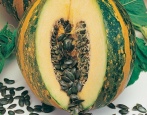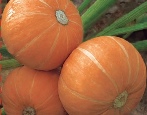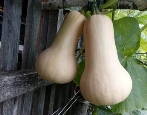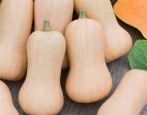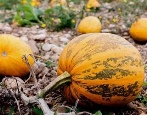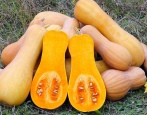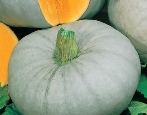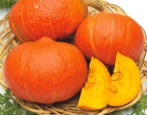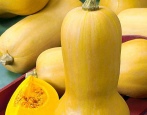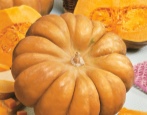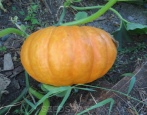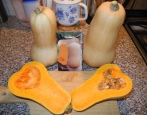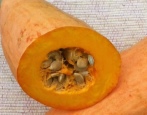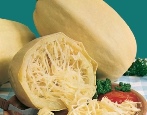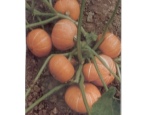
- The form: rounded, slightly flattened
- Weight, kg: 25-30
- Coloration: yellow
- Bark: solid
- Color of the pulp: dark orange
- Pulp (consistency): dense, juicy
- Taste: melon
- Taste qualities: high
- Yield: high
- Ripening terms: mid-early
Among the abundance of melons and gourds, the mid-early pumpkin variety Melonnaya of domestic selection deserves special attention. This is due to unpretentious care, high stress resistance and excellent crop productivity. Even a beginner can grow a vegetable if you familiarize yourself with the intricacies of cultivation and care.
Breeding history
Melon pumpkin is a relatively new variety, developed by domestic scientists of the Poisk agrofirm. After variety testing, in 2006 the vegetable crop was entered into the State Register of Breeding Achievements of the Russian Federation. The vegetable is cultivated in different climatic zones - from the Central region to the Urals and Siberia. In addition, pumpkin is massively grown in Ukraine, Moldova, Belarus.
Description of the variety
This pumpkin species is a creeping plant that has a number of characteristic features. The plant has huge bright green five-lobed leaves with an elongated heart-shaped petiole that reach a length of 30 cm, a powerful stem in the form of a cylinder, as well as a rod-type root system that goes deep into the ground. In addition, the culture has very long lashes, the length of which exceeds 4 meters.
During the growing season, large bright yellow flowers of a single type are formed on the bushes. Flowers are unisexual. Flowering begins in June. Female flowers are located on shortened legs, while male flowers are located on long ones. Pollination in a cross-type cultivar. On each bush, up to 3 large specimens are formed and matured.
Characteristics of the appearance of plants and fruits
Melon pumpkin belongs to the large-fruited category. Very heavy and large vegetables ripen - weighing from 20 to 30 kg. The fruit has a rounded shape with flattened sides. The color of the pumpkin is light yellow or yellow-orange, diluted with noticeable light stripes. The surface of the pumpkin is smooth, but with noticeable ribbing. The bark of the vegetable is thick, rough. There are quite a lot of seeds inside the fruit, but they are not large.
The harvested pumpkins, thanks to their strong peel, can easily be transported over any distance, and are also endowed with a long shelf life - about 12 months.
Purpose and taste
Melon pumpkin is remembered for its excellent taste. The bright orange pulp is characterized by a fleshy, moderately firm, tender and very juicy consistency. The taste is dominated by sweetness and pleasant sugariness, perfectly combined with fruity notes in the aroma, mainly melon. The vegetable contains carotene, organic acids and oils, healthy sugars, and many vitamins.
Grown pumpkins have a universal purpose - they are used to prepare juices, mashed potatoes, jams, salads, cereals, casseroles, used for filling in baked goods, and also added to second courses. In addition, the variety is ideal for baby and dietetic food.
Ripening terms
The pumpkin ripens in the early stages. The growing season lasts 100-110 days. You can taste the vegetable already at the end of July, and the massive harvest takes place in September. The complete ripeness of the specimen on the ridge is indicated by the shrunken stalk, which becomes hard, as well as the uniform color of the vegetable bark.
Yield
The productivity of the variety is excellent. On average, about 45 kg of juicy and healthy vegetables are obtained from 1 m2 of plantings. As a rule, these are 2 large or three medium pumpkins.
Growing and care
Melon pumpkin can be cultivated by seed and seedling methods. When choosing a seed method, it is necessary to select high-quality seeds, prepare a substrate enriched with fertilizers.Planting is carried out in peat or disposable cups, laying two seeds at a depth of 0.5-1.5 cm. It takes 3 weeks to grow bushes. Sowing is carried out at the end of April, and transplanted to the garden in the second half of May. Sowing scheme 100x100 cm.
Sowing seeds in open ground is carried out at a temperature of + 16 ... 18 degrees - the end of May. 2-3 seeds are placed in the prepared holes with an interval of 5 cm.To accelerate the emergence of sprouts, the beds are covered with a film. After sowing, abundant watering with warm water is necessary.
You can grow a vegetable on an area where legumes, onions, greens, and beets previously grew.
The agricultural technology of vegetable crops consists of basic procedures: regular irrigation with settled water (once a week), weeding and loosening of the soil, fertilizing three times per season, forming a bush (pinching the whips), preventing diseases.
Requirements for soil and climatic conditions
The vegetable prefers fertile and high-quality soils, since the taste of pumpkin depends on their structure. The substrate should be light, nutritious, breathable, moisturized and non-acidic. For planting, a leveled, clean area with abundant sunshine, light and protection from drafts is selected.
Disease and pest resistance
The culture has good immunity, but if agrotechnical recommendations are violated, the plant can be exposed to various diseases - bacteriosis, powdery mildew, tobacco mosaic virus, anthracnose, as well as gray, white and root rot. Among the pests attacking melons and gourds, the danger is: aphids, scoops, spider mites, sprout flies.
